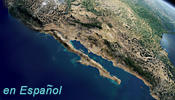![[Ocean Oasis - Teacher's Guide]](images/bnr-oo-tg.gif) |
 |
![[Ocean Oasis - Teacher's Guide]](images/bnr-oo-tg.gif) |
 |
|
|
![[Convection Currents]](images/convection.gif)
What causes fluids to circulate? |
|
In the Film |
Convection currents are identified in Earth's mantle. Heated mantle material is shown rising from deep inside the mantle, while cooler mantle material sinks, creating a convection current. It is thought that this type of current is responsible for the movements of the plates of Earth's crust. In the ocean, warm water is normally found near the surface while the deeper water is usually cold. Deep, cold-water currents play an important role in creating the ocean oasis of the film. |
|
Concept |
Convection currents play a role in the circulation of fluids. |
|
Objective |
To observe convection as a result of differential heating |
|
Content |
Science, language arts |
|
Background |
Convection currents are the result of differential heating. Lighter (less dense), warm material rises while heavier (more dense) cool material sinks. It is this movement that creates circulation patterns known as convection currents in the atmosphere, in water, and in the mantle of Earth. In the atmosphere, as air warms it rises, allowing cooler air to flow in underneath. Along with the turning of the Earth, this movement of air creates winds. Winds, in turn, create surface waves on the ocean. Convection also plays a role in the movement of deep ocean waters and contributes to oceanic currents. Inside Earth, the convection of mantle material is thought to cause the movement of the overriding crustal plates, resulting in events such as earthquakes and volcanic eruptions. |
![[Materials]](images/materials.gif)
Part A
Density and Convection
Part B
Convection Current Class Demonstration |
|
![[Procedure]](images/procedure.gif)
Part A
Density and Convection (small groups)
| |
|
Part B
Convection Current Class Demonstration (small groups)

|
|
|
Local Connection
Key Words |
|
|
Continue to Activity 5: Onshore and Offshore Winds |
Teacher's Guide Contents
Field Guide | Site Index |
Ocean Oasis: The Film
|
|
© 2000 San Diego Natural History Museum |